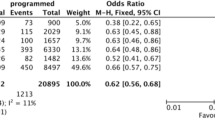Abstract
In the United States alone, an estimated 1–2 million women have used silicone breast implants. Many of these women are of reproductive age. Given the current controversy over the safety of silicone breast implants, medical care providers should be able to advise women if use of these implants affects the use of any of the available contraceptive methods, whether pregnancy is in any way contraindicated and/or might be associated with special complications, whether there are potential risks to the fetus and neonate, and whether breast feeding might be compromised. A review of the literature on these topics yielded very little useful information.
Resumé
Il a été estimé que, rien qu'aux Etats-Unis, 1–2 millions de femmes se sont fait insérer des implants mammaires au silicone. Bon nombre d'entre elles sont d'âge reproductif. Vu la controverse actuelle quant â l'absence de risques de ces implants, les pourvoyeurs de soins médicaux devraient être en mesure de dire aux femmes si l'application de ces implants a des incidences sur l'utilisation de l'une ou l'autre des méthodes contraceptives disponibles, si la grossesse est de quelque manière contre-indiquée et/ou si elle peut être associée â des complications particulières, si les implants présentent un risque potential pour le foetus ou pour le nouveau-né, et si l'allaitement au sein peut être compromis. Une analyse de la littérature â ce sujet n'a révélé que très peu de renseignements utiles.
Resumen
Se estima que, tan sólo en los Estados Unidos, 1–2 millones de mujeres han tenido implantes mamarios de silicona. Muchas de estas mujeres están en edad reproductiva. Data la actual controversia acerca de la seguridad de los implantes mamarios de silicona, los proveedores de atención médica deben poder informar a las mujeres si el uso de estos implantes afecta el uso de cualquiera de los métodos anticonceptivos disponibles, si el embarazo está contraindicado de algún modo y/o si podría estar asociado con complicaciones especiales, si hay riesgos potenciales para el feto y el neonato y si el amamantamiento podría verse comprometido. El examen de la bibliografía disponible sobre estos temas presentó muy poco información útil.
Similar content being viewed by others
References
Kumagai Y, Shiokawa Y, Medsger TA, Rodnam GP. Clinical spectrum of connective tissue disease after cosmetic surgery. Observations on eighteen patients and a review of the Japanese literature. Arthritis Rheum. 1984;27:1.
Fock KMM, Feng PH, Tey BH. Autoimmune disease developing after augmentation mammoplasty: report of 3 cases. J Rheumatol. 1984;11:98.
van Nunen SA, Gatenby PA, Basten A. Post-mammoplasty connective tissue disease. Arthritis Rheum. 1982;25:694.
Baldwin CM, Kaplan EN. Silicone-induced human adjuvant disease? Ann Plast Surg. 1983;10:270.
Kessler DA. The basis of the FDA's decision on breast implants. N Engl J Med. 1992;326:1713.
Edelman DA, Grant S, van Os WAA. Breast cancer risk among women using silicone gel breast implants. Unpublished.
Bloch C, Hudson D. Silicone and breast implants. S Africa Med J. 1992;81:449.
Independent Advisory Committee on Silicone Gel-Filled Breast Implants. Summary of the report on silicone-gel-filled breast implants. Canadian Med Assoc J. 1992;147:1141.
Ersek RA. Rate and incidence of capsular contracture: a comparison of smooth and textured silicone double-lumen breast protheses. Plast Reconstr Surg. 1991;87:879.
Baker JL. Augmentation mammaplasty. In: Owsley JQ, Peterson RA, eds. Symposium on Aesthetic Surgery of the Breast. St Louis: CV Mosby; 1978:256.
de Cholnoky T. Augmentation mammaplasty. Survey of complications in 10,941 patients by 265 surgeons. Plast Reconstr Surg. 1970;45:573.
Riddick DH. The breast during pregnancy and lactation. In: Sciarra JJ, ed. Gynecology and Obstetrics, vol 5. Endocrinology, Infertility, Genetics. Philadelphia: JB Lippencott Co.;1988:1.
Silver RM, Sahn EE, Allen JA, Sahn S, Greene W, Maize JC, Garen PD. Demonstration of silicon in sites of connective tissue disease in patients with silicone-gel breast implants. Arch Dermatol. 1993;129:63.
Truong LD, Cartwright J, Goodman MD, Woznicki D. Silicone lymphadenopathy associated with augmentation mammaplasty. Morphologic features of nine cases. Am J Surg Pathol. 1988;12:484.
Whidden PG. Augmentation mammoplasty. Transplant/Reconstr Today. 1986;3:43.
Levine JJ, Ilowite NT. Sclerodermalike esophageal disease in children breast-fed by mothers with silicone breast implants. J Am Med Assoc. 1994;271:213.
American Association of Plastic and Reconstructive Surgeons. Latest plastic surgery statistics show eye surgery most popular cosmetic procedure. News release, July 16, 1993, Arlington Heights, IL.
Edelman DA, Grant S, van Os WAA. Autoimmune disease following the use of silicone gel-filled breast implants: a review of the clinical literature. Unpublished.
Dugowson CE, Daling J, Koepsell TD, Voigt L, Nelson JL. Silicone breast implants and risk of rheumatoid arthritis. Arthritis Rheum. 1992;35:S66 (Abstract).
Weisman MH, Vecchione TR, Albert D, Moore LT, Mueller MR. Connective-tissue disease following breast augmentation: a preliminary test of the human adjuvant disease hypothesis. Plast Reconstr Surg. 1988;82:626.
Schusterman MA, Kroll SS, Reece GP, Miller MJ, Ainslie N, Halabi S, Balch CM. Incidence of autoimmune disease in patients after breast reconstruction with silicone gel implants versus autogenous tissue: a preliminary report. Ann Plast Surg. 1993;1:1.
Author information
Authors and Affiliations
Rights and permissions
About this article
Cite this article
Grant, S., Edelman, D.A. Pregnancy, lactation and the use of silicone breast implants. Adv Contracept 10, 187–193 (1994). https://doi.org/10.1007/BF01983350
Received:
Accepted:
Issue Date:
DOI: https://doi.org/10.1007/BF01983350




